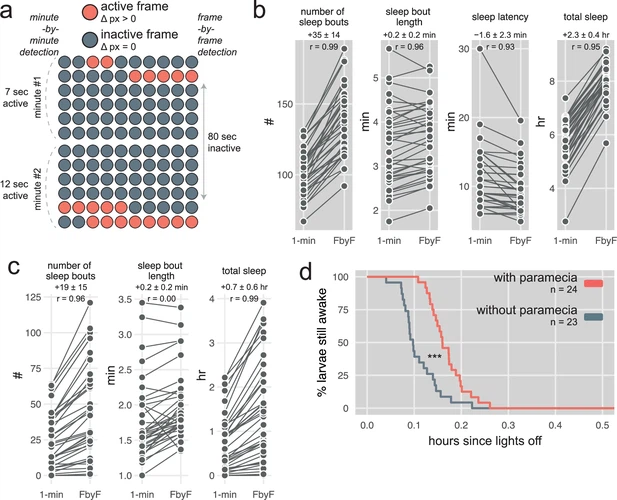Fig. 2 - Supplemental 2 Sleep detection by the FramebyFrame R package. (a) Example of a sleep bout detected by the FramebyFrame R package that is missed by analysis done on 1-min epochs. In this example, the larva was inactive for 80 consecutive seconds, which represents a sleep bout as per the 1-min inactivity criterion for sleep (Rihel et al., 2010b). Binning in 1-min epochs misses the sleep bout as it returns two active minutes with 7 and 12 s of activity per minute, while the FramebyFrame package detects the 80 s sleep bout. (b) Difference in sleep parameters measurements between the 1-min analysis and the frame-by-frame analysis performed on the same dataset. One line represents one wild-type larva during one night. 1-min, results obtained with the minute-by-minute detection; FbyF, results obtained with the FramebyFrame R package; r, Pearson correlation. (c) Difference in sleep parameters measurements between the 1-min analysis and the frame-by-frame analysis, as in (b). One line represents one wild-type larva during one day. (d) Example of a sleep latency survival plot generated with the FramebyFrame R package. Starting at lights-off, larvae that experienced their first sleep bout were gradually removed from the survival curve. At any timepoint, the larvae with paramecia in the well were 68 ± 31% less likely to fall asleep for the first time than larvae housed without paramecia: hazard ratio for larvae with paramecia = 0.32 ± 0.31, *** p<0.001 by likelihood-ratio test.
Image
Figure Caption
Acknowledgments
This image is the copyrighted work of the attributed author or publisher, and
ZFIN has permission only to display this image to its users.
Additional permissions should be obtained from the applicable author or publisher of the image.
Full text @ Elife

